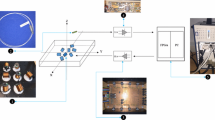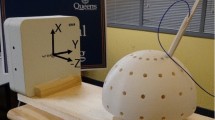Abstract
Tracking systems for surgical instruments are analyzed. The possibility of using electromagnetic positioning systems is demonstrated. The characteristics required of the control system of field formation and those of the transmitters and receivers are determined. Block diagrams of an electromagnetic tracking system for surgical instruments are presented.
Similar content being viewed by others
INTRODUCTION
The acceleration of technological progress and improvements in the quality of life in developed countries are accompanied by a continuous increase in the number of new developments in almost all fields of human activity. The breakthrough in medical technologies caused by the evolution of electronics, mechanics, and software is one powerful synergistic effect of recent years. Many surgical procedures for which invasive surgery and many days of patient rehabilitation were needed two decades ago are now performed on an outpatient basis, with minimal damage to body tissues. This is observed in ophthalmology, gastroenterology, traumatology, and other fields [1–4].
In addition to the classic scalpel, disposable multifunction tools are used as surgical instruments. These combine the possibilities of physical manipulation (mechanical microscalpels, local heaters, lasers), delivering medicines (with dissolving microampoules that contain a desired medication), and diagnostics (physicochemical sensors, video cameras, histological samplers). This variety of new tools gave doctors tremendous opportunities for improving the quality, duration, and reliability of patient treatment, along with lowering its cost. However, it is clear that this revolution in therapeutic practice is still in its initial stage, and the developers of medical equipment face many new challenges.
One of the most important problems today is obtaining information on the exact location of a surgical instrument inside a patient’s body during an operation, due both to the need to control and monitor the impact of surgery itself, and to track the path of a surgical instrument and solve the still serious problem of lost scalpels.
Internet search engines provide a great many links to the topic of surgical instrument tracking (SIT), and the value of the steadily growing world market of trackers is estimated to be hundreds of billions of U.S. dollars [5].
There are two fundamental concepts of SIT: contact and contactless. Contactless SIT, the one most relevant and noninvasive, can in turn be divided according to the principle of information transfer: mechanical, ultrasonic, magnetic, magnetic resonance, optical, electronic, and RF (built-in microcontrollers and radio modules) [6]. Since most operations are performed with instruments made of high-graded steel, magnetic positioning systems (MPS) are especially popular. Even though magnetic SIT is provided by several foreign companies [7, 8], real competition in the market is just beginning. Meanwhile, the development of these devices in Russia is practically in its infancy, and there are still no products ready for sale in the medical industry.
The aim of this work a therefore to solve the problem of developing a prototype SIT device based on the available circuitry that can quickly be put into mass production under the conditions of the current state of industry and medicine in the Russian Federation.
BASIC DESIGN OF THE MPS UNDER DEVELOPMENT
The fundamental Biot–Savart–Laplace law and the Hall effect serve as the bases for measuring the coordinates of an object’s location via magnetic positioning. A generalized block diagram of our MPS is presented in Fig. 1.
Surgical instrument (SI) 4 is in patient 1. N antennae of transmitter TS (inductance coils) 3 are arranged to create an a priori fixed distribution of the strength of the magnetic field inside the patient that encompasses the SI. M receivers RS (Hall sensors) 2 allow the distributed magnetic field disturbed by the surgical instrument to be measured.
Control system 5 generates modulated signals for the transmitter and processes the receiver’s data signals. Control system 5 contains (Fig. 2) TS power amplifiers 3; digital-to-analog converters 2; low-noise RS scaling amplifiers 6 with bandpass filters for noise reduction; analog-to-digital converters 5; TS signal generator 1; RS response handler 4; a control program on a personal or built-in computer; a user interface; and optional communication system 7 with cloud storage.
The algorithms of transmitter signal generation and receiver response processing have been described in many works [9–11], so we do not present them here. Let us consider in more detail the principles behind selecting the circuitry and assessing the functionality of the MPS under development.
SELECTING THE CIRCUITRY FOR THE SIT CONTROL SYSTEM
To obtain specific indicators of performance (the accuracy of three-dimensional positioning to within several millimeters and the rate of measuring in fractions of a second), we reviewed existing sources of information and found the values presented in Table 1 for the minimum configuration of an MPS.
When selecting the electronic components of the system under development, we must be guided by both their price and availability for a minimum of 10 years from the moment a product enters the market. Since there are no products of Russia’s electronic industry that meet today’s requirements of functionality, being lead-free, and having low power consumption, we analyzed the analog and digital element base of the world’s leading manufacturers (Analog Devices [12], Texas Instruments [13], Microchip [14], National Instruments [15], Linear Technology [16], Xilinx [17], Altera [18], and FTDI [19]) and electronics distributor DigiKey [20].
To shape and process signals in real time, we proposed not using computing systems that run with operating systems (all types of PCs, Raspberry Pi, and Arduino) and use specialized signal processors manufactured by Microchip (e.g., dsPIC of at least generation 33) instead, with hardware execution of integral transform algorithms. An alternative could be executing mathematical algorithms in real time on field-programmable gate array (FPGA) logic circuits.
Even though the signal controllers have built-in ADCs and DACs, in order to achieve the maximum rate and parallel processing, it makes perfect sense to use analog-to-digital converters of other designs with serial interfaces for FPGAs with either parallel or four-bit queued serial peripheral interfaces (QSPIs) where microcontrollers are concerned. There is a good selection of components from Analog Devices and Linear Technology for this.
The best solution for executing the analog part of powerful current amplification is to use Texas Instruments’ OPA series of operational amplifiers (e.g., OPA48). Low-noise integrated amplifiers suitable for receiving the signals from Hall sensors can come from, e.g., Analog Devices (AD604, AD603, AD8331) or Linear Technology.
It should be noted that such an approach to selecting components for SIT control systems offers a good opportunity to create portable tracking devices with battery power, since all selected components have low energy consumption. This makes the system under development more universal, in the sense that it can be used not only in medical establishments, but in field operations as well.
CONCLUSIONS
Our analysis of the design of an electromagnetic tracking system of surgical instruments was the final stage before developing electric circuit diagrams and control programs to produce a fully functional product for the medical industry. subsequent efforts will focus on designing prototypes and drawing up the technical requirements for certification and clinical trials. The results can be used by both hardware developers and analysts of contemporary medical instruments.
REFERENCES
Khakimova, D.R., Extended Abstract of Cand. Sci. (Med.) Dissertation, Moscow: Sechenov Univ., 2004.
Lau, J.Y., Sung, J., Hill, C., et al., Digestion, 2011, vol. 84, p. 102.
Ivashkin, V.T. and Sheptulin, A.A., Bolezni pishchevoda, zheludka i kishechnika (Diseases of the Esophagus, Stomach, and Intestinal Tract), Moscow: MEDpress-inform, 2009.
Sorokina, E.V. and Krasnogorskaya, V.N., Byull. Fiziol. Patol. Dykhaniya, 2013, no. 48, p. 105.
https://www.grandviewresearch.com.
Zhelamskii, M.V., Elektromagnitnoe pozitsionirovanie podvizhnykh ob"ektov (Electromagnetic Positioning of Mobile Objects), Moscow: Fizmatlit, 2013.
https://www.ascension-tech.com/products/.
https://polhemus.com/motion-tracking/all-trackers.
Marins, J.L., Yun, X., Bachman, E.R., et al., Proc. IEEE/RSJ Int. Conf. on Intelligent Robots and Systems, Maui, 2001, vol. 4, p. 2003.
Young, D.G. and Finch, P.D., US Patent 4362992, 1982.
Godunov, V.A., Zhelamskii, M.V., Metelkina, T.V., et al., Mekhatron., Avtom. Upr., 2007, no. 3, p. 46.
https://www.analog.com/en/index.html.
http://www.ti.com.
https://www.microchip.com.
http://www.ni.com/en-us.html.
https://www.analog.com/en/index.html.
http://www.xilinx.com.
http://www.altera.com.
https://www.ftdichip.com.
https://www.digikey.com.
ACKNOWLEDGMENTS
This work was supported by the RF Ministry of Education and Science, project RFMEFI577170254 “An Intraoperational Navigation System for Minimally Invasive Surgery with the Support of Augmented Reality Technology Based on Virtual 3D Models of Organs, Obtained Using the Results from CT Diagnostics.”
Author information
Authors and Affiliations
Corresponding author
Additional information
Translated by M. Kromin
About this article
Cite this article
Grunin, L.Y., Rozhentsov, A.A. & Khalimov, M. Design Principles of an Electromagnetic System for Surgical Instrument Tracking. Bull. Russ. Acad. Sci. Phys. 82, 1522–1524 (2018). https://doi.org/10.3103/S1062873818120092
Published:
Issue Date:
DOI: https://doi.org/10.3103/S1062873818120092






